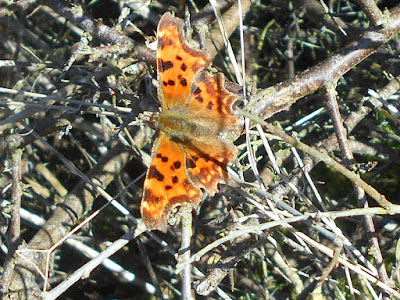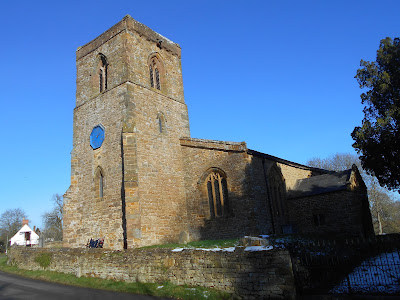I don't care what the calendar says, spring began at 7
.35 am today, when I threw open our bedroom curtains to see the sun climbing in a Cambridge blue sky. Of course we've had blue skies on several days recently but today the sunshine was accompanied by frost-free and noticeably warmer conditions.
The morning was spent in the garden, tearing out clumps of Sea Heath and other plants which were threatening to overwhelm parts of the rock garden. I didn't want the crocuses and dwarf irises, Iris reticulata, to disappear beneath a sea of green.
 |
Iris reticulata was in danger of being overwhelmed by Sea Heath.
Our front garden on Stefen Hill. 11 February, 2019
|
During the morning Chris was out walking with friends but on her return we had a quick lunch and I then set out for Foxhill Farm, this time looking at the area around the windmill. I was met, as usual, by inquisitive sheep and today they were cuddly beasts with a soft grey fleece. I'm no expert but I believe they were Herdwicks.
 |
Herdwick sheep? Foxhill Farm, near Badby, Northants.
11 February, 2019
|
The bricks forming the windmill tower were distinctly warm to the touch and I expected to find many flies basking in the sun but was surprised to find only one. Rather predictably it was Calliphora vicina, Britain's commonest blowfly. Frequently the brickwork attracts dozens of these insects.
 |
A male blowfly, Calliphora vicina, basking on the brickwork of Newnham
Windmill. 11 February, 2019
|
The only other insect enjoying this warm microclimate was a Harlequin Ladybird, Harmonia axyridis. I saw a dozen or so ladybirds during the afternoon but pleasingly all the others were Seven-spot Ladybirds. (Actually that's wrong: later on I found a couple of the tiny yellow 16-spot Ladybirds, Tytthaspis 16-punctata.)
 |
Only one Harlequin Ladybird was seen but I'm afraid there will be
lots more as the season moves on. 11 February, 2019
|
The area below the windmill, known as Beggar's Bank, is interesting and over the years this could eventually develop a rich fauna and flora, although not in my lifetime.
 |
The vegetation below the windmill shows lots of promise.
Foxhill Farm, 11 February, 2019
|
A nearby patch of woodland (all planted) bore a ground flora of snowdrops and winter aconites. At least two taxa* were present: one was fully in bloom and the other was barely in bud.
 |
Many snowdrops were in flower in woodland on Beggar's Bank.
Foxhill Farm, 11 February, 2019
|
The Winter Aconite, Eranthis hyemalis, is a particularly early species, as its name suggests. Eranthis comes from the Greek er, spring and anthos, a flower. However, hyemalis means 'pertaining to winter'. Fair enough because, despite my opening sentence, it is still technically winter. Thanks to an early flowering period its seeds should have fully formed and ripened before the trees cast a deep shade.
 |
Winter Aconites created a splash of golden yellow on the woodland floor.
11 February, 20119
|
Bright sunshine or not, there were very few insects around, but clumps of gorse yielded a few spiders and true bugs. Now it over to the microscope to find out what I've found.
* Taxa. The singular is taxon and is a convenient term for any taxonomic group such as a genus or species or even variety.






























